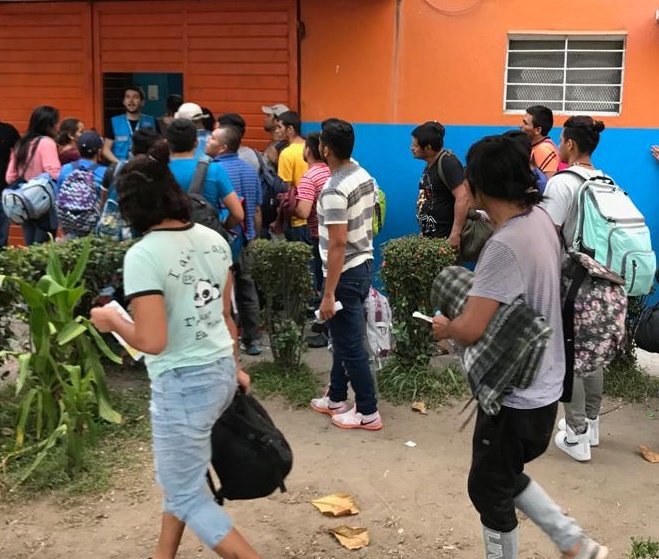
OTTAWA — The United Nations is urging Canada to help ease Mexico’s refugee burden by helping resettle some of the most vulnerable of its new arrivals, including women, children and LGBTQ people.
Mexico is feeling the squeeze from an unprecedented exodus of people fleeing Central American countries and some of the worst violence from nations not at actually war is forcing families northward.
“Our pitch to Canada is to do more,” said Mark Manly, the Mexico representative of the United Nations High Commissioner for Refugees.
Manly was in Ottawa earlier this month for meetings with the federal government to look for ways for Canada to help resettle more of the migrants that have arrived in Mexico.
The request comes as the United States takes a harder line on its Mexican border, with President Donald Trump branding the caravans of migrants as being laced with violent criminals bent on destabilizing his country.
Canada, Mexico and the U.S. are pushing to have their new version of the North American Free Trade Agreement ratified soon as Vice-President Mike Pence visits Ottawa this week to give that a renewed push.
Asylum seekers reaching Mexico from Honduras, El Salvador and Venezuela caused a 103-per-cent spike in claims in 2018 over the previous year, from almost 15,000 to about 30,000, says the UNHCR.
Manly said that many migrants have good settlement prospects in Mexico because of its growing economy and need for foreign labour, but women and girls fleeing gang violence as well as members of the transgender and gay communities need to be resettled elsewhere because they are not safe.
The UNHCR wants to “take the pressure off Mexican authorities to take care of this kind of profile and resettle them to Canada,” Manly said.
Criminal gangs are flourishing in Central America, he said. They extort money from the non-criminals, kill other gang members, and are constantly recruiting adolescent boys and girls.
“Anyone who gets in the way is at severe risk, so entire families leave,” Manly explained. “That explains the demographic change.”
Canada is already “doing a few things in terms of technical support for the Mexican asylum system, resettlement of people who face extreme protection risks in the region,” he added, including helping resettle LGBTQ applicants.
“These are countries that are close by; they are countries with which Canada has close ties, Mexico being the most important of them.”
A spokeswoman for Immigration Minister Ahmed Hussen was unable to provide statistics of how many Mexican asylum seekers Canada has received recently.
But Lise Jolicoeur said Canada is a partner in the Rainbow Refugee Society which helps sponsor LGBTQ2 refugees from around the world. “In fact, this year we managed to sponsor 64 refugees (record-breaking),” she said in an email.
The Ontario-based World Refugee Council released a report earlier this year that said the large-scale migration of Central American women, as well as unaccompanied children and adolescents, had become a major policy issue in the Western Hemisphere.
“It is estimated that six out of 10 migrant women and girls are victims of sexual violence carried out by illicit actors, government authorities and intimate partners. However, most of what is known is anecdotal and there is an urgent need for a stronger evidence base in order to inform policy,” the report says.
Lloyd Axworthy, the chair of the refugee council, toured Mexican refugee camps near the border city of Tijuana last year at the height of the caravan activity, and described the situation as dire and entrenched.
Axworthy made “human security” a key tenet of Canadian foreign policy when he was the country’s top diplomat in the Liberal government from 1996 to 2000.
“What it demonstrates is that as long as the conflicts take place and the violence going on, you’re going to have people trying to escape. And it’s going to be in our region,” he said in an interview.
“We’ve been focusing on the NAFTA issue; well maybe there’s got to be some parallel discussion (on migration).”
The long and occasionally bitter NAFTA renegotiation highlighted the differences on dealing with gender issues between the U.S. and its two continental partners.
In the new deal’s chapter on labour rights, it calls on all three countries to “protect workers against employment discrimination on the basis of sex (including with regard to sexual harassment), pregnancy, sexual orientation, gender identity ?”
That paragraph also has a footnote that essentially gives the U.S. an out on that point, saying it need not take “any further action” to comply with that requirement. The footnote came after 40 U.S. members of Congress wrote Trump a letter in November 2018 objecting to sexual orientation and gender identity language in the trade deal.
“A trade agreement is no place for the adoption of social policy,” their letter said. “It is especially inappropriate and insulting to our sovereignty to needlessly submit to social policies which the United States Congress has so far explicitly refused to accept.”